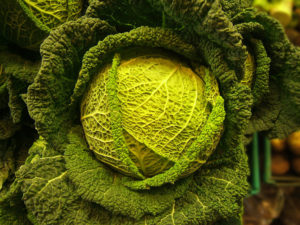With the popularity of so many cooking shows, these days, this has become a very popular question. What is savoy cabbage? More importantly, why are so many of the top chefs and cooks using it? Let’s get those questions answered.

Despite its rough looking exterior, the Savoy cabbage is tender and sweet tasting.
But that brings to one of the many traits that makes savoy cabbage so popular with cooks and chefs.
Despite this rough appearance, the leaves of the savoy cabbage are tender, even when eaten raw. This makes them an ideal choice for salads, vegetable wraps, or as a bed for rice, fish, or other dishes. This in sharp contrast to the leaves of “green” or “red”cabbages, that are hard and rubbery. Their only real use, in the raw state, is in making coleslaw. Even then, the texture can be too tough for many people to enjoy. On the other hand, savoy cabbage can make a tastier, and much more tender coleslaw.
Savoy Cabbage is a milder and sweeter alternative to green or red cabbage cabbage
While the tenderness is a huge factor in the appeal of savoy cabbages, over other forms of cabbage, its taste is another reason for its popularity. The green and red cabbages have a slightly bitter taste, which some describe as peppery. Savoy cabbage, by comparison, is milder and sweeter, making it not only a good fit in salads, but also a much preferred alternative in just about any recipe that includes cabbage.
The nutritional and health benefits of savoy cabbage
Like the rest of the cabbage family, savoy cabbage has high nutritional value. It is very low in calories, and contains no fat or cholesterol. It is a good source of dietary fiber, and protein. It is also rich in many vitamins and minerals, such as: Thiamine (B-1), folic acid, vitamin A, vitamin B6, magnesium, potassium, manganese, calcium, copper, phosphorous, and copper. They are also an excellent source of both Vitamins K and C. Each of the different types of cabbage have high nutritional value, as well as tremendous antioxidant and disease combating properties. These properties make cabbage one of the worlds healthiest foods.
Savoy cabbage is the most tender and sweet variety of cabbage
As mentioned above, its tender leaves, and sweet taste, make it an ideal choice to eat raw in salads. These qualities also make it the preferred option in most recipes that include cabbage. In addition to its taste and texture, on the other highly beneficial trait is that it lacks the sulfur-like odor that most people, who have cooked cabbage, are more than familiar with. This makes Savoy cabbage the perfect choice of cabbage for cooking, as well.

Comments
What is Savoy Cabbage? — No Comments
HTML tags allowed in your comment: <a href="" title=""> <abbr title=""> <acronym title=""> <b> <blockquote cite=""> <cite> <code> <del datetime=""> <em> <i> <q cite=""> <s> <strike> <strong>